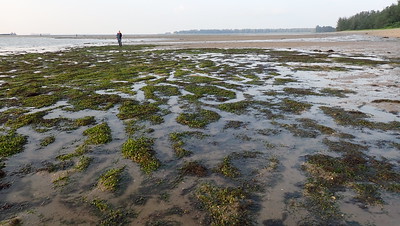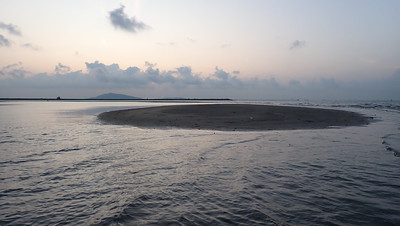 |
| Dugong feeding trails at the Northern edge. |
Today, we saw lots of dugong feeding trails on both the southern and northern corner of this vast shore. We encountered lots of sand-dwelling animals and at sunrise, the otters visited. This area is strictly off limits without a permit. We surveyed with permission from various agencies kindly arranged by NParks.
On the Southern edge of the sandy area, there are also dugong feeding trails on the patch of seagrasses that are exposed at low tide. On the Northern edge a much larger patch of seagrasses are exposed at low tide and it had a lot more dugong feeding trails.
Dugong feeding trails are formed when dugongs chomp up seagrasses including their roots, leaving a shallow meandering furrow of about equal width and depth.
Today, I noticed mainly Spoon seagrass (large leaves and small leaves).
Today, I made the long long trek out to the huge sand bars that extend far out perpendicularly from the shore at low tide.
The small sand bar at the south that started from the high shore seems to have moved east and north, so that a shallow lagoon is being formed behind a ring of sand. Hopefully, this will encourage growth of more seagrasses for the dugongs to eat.
On the sand bars, there are lots of interesting sand-dwellers that are less commonly seen elsewhere. Because they prefer such vast sandy habitats which are no longer common in Singapore. Mainly a lot of moon snails! For the first time, I saw what might be a Zebra moon snail! The most abundant were Ball moon snails, but I also saw many Egg-white moon snails and other predatory snails such as Weasel olive snail, Fig snail, Grey bonnet snail, Margined conch. As well as the predatory Attap chee slug which is believed to eat clams. There were a lot of pretty Noble volutes.
The most abundant animals on the shore remain Cake sand dollars. I also saw many signs of Button snails. We saw many live Thick-edged sand dollars which are not common on our shores. Sandy areas are great for burrowing animals like Remarkable sea cucumbers and Spiky sea pens as well as Sea pencils. An abandoned tyre had become a shelter for a Haddon's carpet anemone which in turn was home to a pair of tiny Peacock-tail anemone shrimps. We also saw a Glass anemone and Pearly anemone.
The bright spot in the sky is not the sun rising. It is petrochemical flaring at Pengerang, Johor which we have observed on our previous surveys as well.
What is the fate of this shore?
In Jul 2022, it was announced that the entire Lost Coast area will be reclaimed again.

Where?
The 900ha reclamation will bury all of the 'Lost Coast' at the eastern most part of Changi.
Why?
For purposes that appear yet to be determined by the authorities. In the Long-Term Plan Review, the area is marked as 'Reserve Site'. Planned reclamation at Chek Jawa in the Plan is also marked as 'Reserve Site'.
When?
Works is said to start soon, around the third quarter of 2022. It is expected to take about 5-10 years to complete the reclamation.
But today, there was no sign of any works at the southern-most end of the Lost Coast where reclamation is said to start first.
Others on this survey: Marcus Ng, Che Cheng Neo, Tommy Arden, Nicholas Yap.
Marcus Ng
Tommy Arden
Che Cheng Neo










